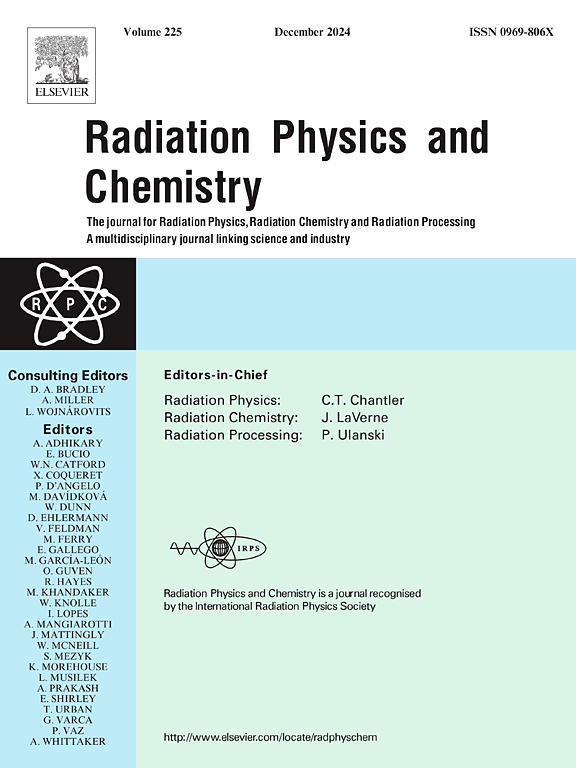Photo-thermal- luminescence traits of beta-ray irradiated fluoroborate glasses doped with Sm3+
IF 2.8
3区 物理与天体物理
Q3 CHEMISTRY, PHYSICAL
引用次数: 0
Abstract
The aim of this investigation was to study the photoluminescence (PL) and thermoluminescence (TL) of fluoroborate glasses doped with different weighted mole percentages of samarium oxide (Sm2O3) after exposure to ionizing radiation. The changes in PL and TL with different Sm concentrations in fluoroborate glass were studied. Based on the PL characterization, samarium (Sm3+) had a broad fluorescence spectrum; its emission peak was at λemi = 604 nm, with several excitation bands. The electronic transition from 6H5/2 to 6P3/2 at 408 nm had a maximum intensity and was used for emission spectrum studies. The excitation caused the samples to produce photons from 4G5/2 to lower states 6H5/2, 6H7/2, 6H9/2, and 6H11/2, resulting in visible photoluminescence for radiative decay from reddish orange. The results indicated that glass containing 0.7 mol% of Sm2O3 exhibited the maximum NBOs as determined by PL. In addition to measuring changes in PL and TL at different doping concentrations, dosimetric properties, namely, signal dose-response, repeatability, lower detectible limit, and thermal fading were examined for the 0.7 mol doped samples. Results showed that both experimental and computational analysis methods indicated that the TL glow curves were composed of 10 overlapping carriers’ traps. The signal dose response study revealed linear behavior for most traps in the dose range of 22 Gy–1375 Gy. The estimated value of the low detectable limit was calculated to be 29.9 mGy.
掺杂Sm3+的射线辐照氟硼酸盐玻璃的光热发光特性
本研究的目的是研究掺杂不同重量摩尔百分比的氧化钐(Sm2O3)的氟硼酸盐玻璃在电离辐射照射后的光致发光(PL)和热致发光(TL)。研究了氟硼酸盐玻璃中PL和TL随Sm浓度的变化。根据PL表征,钐(Sm3+)具有较宽的荧光光谱;其发射峰在λemi = 604 nm处,有多个激发波段。从6H5/2到6P3/2在408 nm处的电子跃迁强度最大,并用于发射光谱研究。激发使样品产生从4G5/2到6H5/2、6H7/2、6H9/2和6H11/2的光子,产生红橙色辐射衰变的可见光致发光。结果表明,Sm2O3含量为0.7 mol%的玻璃具有最大的NBOs。除了测量不同掺杂浓度下PL和TL的变化外,还研究了0.7 mol掺杂样品的剂量学性质,即信号剂量响应、可重复性、检测下限和热衰减。结果表明,实验和计算分析方法均表明,TL发光曲线由10个重叠载流子陷阱组成。信号剂量响应研究表明,在22 Gy至1375 Gy的剂量范围内,大多数陷阱具有线性行为。低可探测限度的估计值计算为29.9毫戈瑞。
本文章由计算机程序翻译,如有差异,请以英文原文为准。
求助全文
约1分钟内获得全文
求助全文
来源期刊

Radiation Physics and Chemistry
化学-核科学技术
CiteScore
5.60
自引率
17.20%
发文量
574
审稿时长
12 weeks
期刊介绍:
Radiation Physics and Chemistry is a multidisciplinary journal that provides a medium for publication of substantial and original papers, reviews, and short communications which focus on research and developments involving ionizing radiation in radiation physics, radiation chemistry and radiation processing.
The journal aims to publish papers with significance to an international audience, containing substantial novelty and scientific impact. The Editors reserve the rights to reject, with or without external review, papers that do not meet these criteria. This could include papers that are very similar to previous publications, only with changed target substrates, employed materials, analyzed sites and experimental methods, report results without presenting new insights and/or hypothesis testing, or do not focus on the radiation effects.
 求助内容:
求助内容: 应助结果提醒方式:
应助结果提醒方式:


